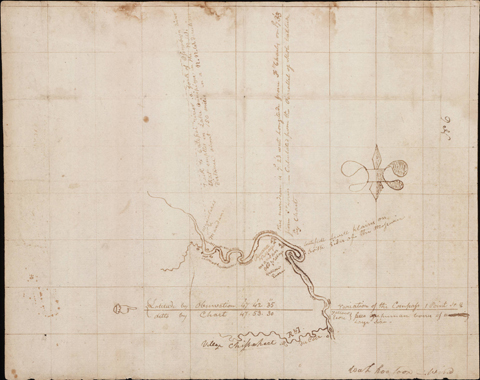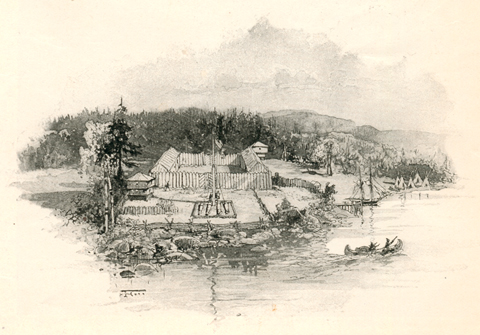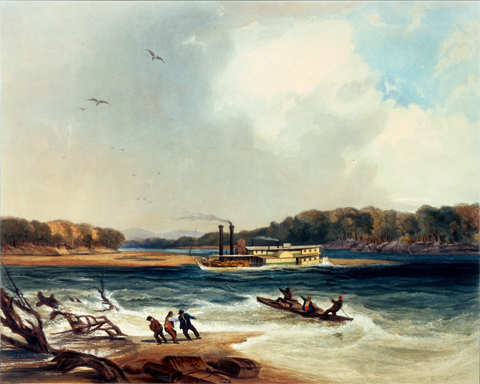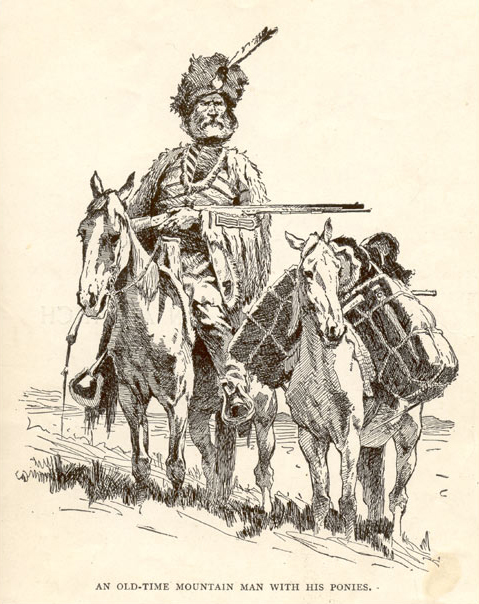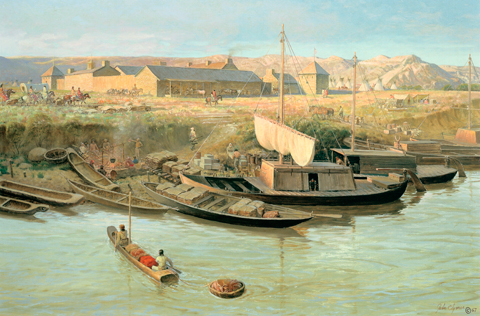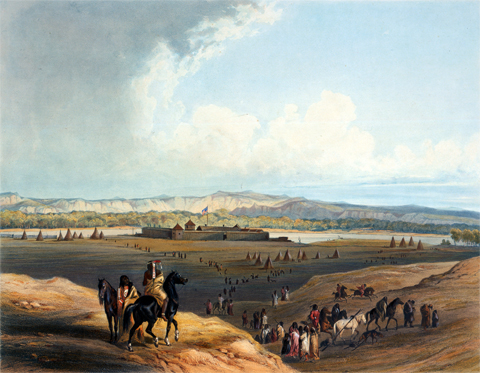The North American fur trade was well-established long before Lewis and Clark led an expedition up the Missouri River. The captains were intent on switching Native American loyalties from European-based companies to those working under the authority of the young United States. Were they successful in changing the fur trade after the expedition?
Figure 1
John Evans Maps with Annotations by Clark
North and South Dakota Boundary
To see labels, point to the map.
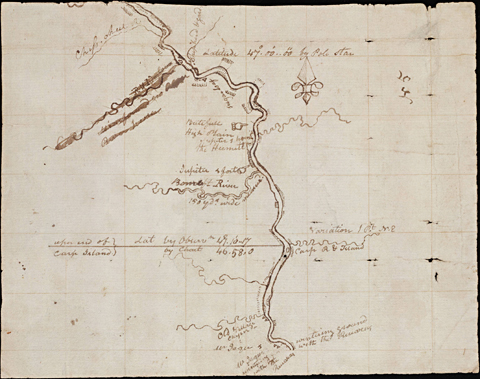
Beinecke Rare Book and Manuscripts Library, Yale University.
The Missouri River from the modern North and South Dakota border and the Heart River, the “heart” of traditional Mandan country. The river at upper left is labeled “Chiss-chect R” in Clark’s hand; the next southern tributary down the Missouri was also crossed out by Clark.
Sometime in August 1807, Meriwether Lewis penned a long essay that Nicholas Biddle published in the appendix to his 1814 paraphrase of the captains’ journals as “Observations and reflections on the present and future state of Upper Louisiana, in relation to the government of the Indian nations inhabiting that country, and the trade and intercourse with the same.” It was an insightful commentary on the conditions of trade during the former Spanish regime, and a remarkably accurate prediction of the future problems facing the new territory. He foresaw that a main evil confronting the region would be subsistence hunting by whites on Indian land, incidents, he predicted, that would be “the most frequent causes of war, hostile to the views of civilizing and of governing the Indians.” He went on to say that “the first principle of governing the Indians is to govern the whites,” and noted the impossibility of this without a military presence. Also, he pointed out the dangers of traders introducing “whiskey or ardent spirits” without government knowledge, presaging the later ban—with indifferent results—on importing alcohol into Indian country.[1]Jackson, Letters, 2:718-19. During the winter at Fort Mandan, William Clark drafted a proposal for a network of twelve military posts “to protect the Indian trade and Keep the savages in peace with the U.S. and each other.” He estimated that a total of 1,805 frontier soldiers would be required (who would also act as boatmen), which by itself would have been hard to meet, in view of President Jefferson’s Military Peace Establishment Act of 1802, an economy move which limited the standing army to 3,289 officers and men, a force which was already so widely dispersed among posts east of the Mississippi that none could have been spared. But even 1805 soldiers would hardly have been adequate to a peace-keeping role, in view of Clark’s own estimate of 17,660 Indian warriors in the upper Louisiana territory. Needless to say, both mens’ strategies would most likely have been doomed to failure.
On 26 September 1806, Lewis and Clark returned to St. Louis and had been met by a tumultuous welcome. The news they brought with them of the furs to be obtained in the west was of great interest to the participants in this great mid-continental center of the fur industry. But its entrepreneurial residents had not waited for the return of the expedition with this news, for they had been exploiting the river for decades. Indeed, on their way up the Missouri in 1804 the Corps of Discovery met several traders on their way back to St. Louis with furs obtained on the Upper Missouri. Some were returning with prizes, though the two Frenchmen they met below the Mandans complained that they had been robbed of their furs by that tribe near present-day Bismarck.[2]Moulton, Journals, 3:182. By the time the Corps returned, dozens of men were going up the Missouri to seek their fortunes. Indeed, John Colter was given permission to leave the Corps on its return and accompany two such traders, becoming one of the first of the famous “mountain men.”[3]The Missouri River had been explored as far as the Platte River by 1714, followed by numerous individual traders. See Early Missouri River Fur Trade.
The Fur Trade After the Expedition
Figure 2
Heart River to Knife River
To see labels, point to the map.
Beinecke Rare Book and Manuscripts Library, Yale University
The Missouri River from the Heart River to the Knife River, showing the location of the Mandan and Hidatsa villages at the terminus of the more than 200-mile-long “Mandan trail” to the Qu’Appelle River used by Canadian traders. The explanation of the “Track o the Catepoi river”—the Qu’Appelle (“who calls?”) River—was written by James Mackay. “Village Chiss.chect” and “Wah hoo toon—Wind” are in Clark’s hand.
The Louisiana Purchase and the lure of its beaver population led to a veritable flood of traders and trappers moving toward the Upper Missouri and the Northern Rocky Mountains. On the other hand, the increasing traffic from St. Louis in what was now American territory led to the slow abandonment of the overland trade in the United States by Canadian and British interests. By 1822 these economic invaders from the north had given up their interests in the Mandan and other residents of the new territory held by the United States.
In 1803, General James A. Wilkinson, the first governor of Louisiana Territory, was instructed to select a site for a military installation and a government trading post, and he established Cantonment Belle Fontaine, a few miles northwest of St. Louis (see Camps Dubois and Belle Fontaine). In 1805, Wilkinson also sent out two expeditions—Lt. Zebulon M. Pike up the Mississippi, and Pierre Chouteau to the Osage Indians, to explore the newly-purchased region and choose sites for new trading posts. When Governor Wilkinson was removed from office in the summer of 1806 he was replaced by Meriwether Lewis, and William Clark was appointed the United States Indian Agent for all of the tribes in Louisiana except the Osages. Both men were popular heroes in the region, and indeed throughout the nation.[4]William E. Foley, The Genesis of Missouri: From Wilderness Outpost to Statehood (Columbia: University of Missouri Press, 1989), 178-82.
Lewis’s new administration was concerned about the possibilities of Indian warfare in the western frontier. When he arrived in St. Louis as governor in 1808, Lewis found that the Sac and Osage were upset at their treatment by the government.
That July, Governor Lewis wrote to Secretary of War General Henry Dearborn, advocating strong measures to counter them. Because Dearborn was not in Washington when the letter arrived, President Jefferson wrote to Lewis to express his own ideas on American-Indian relations, in which he decried war on Indians, commenting that “commerce is the great engine by which we are to coerce them & not war.”[5]Thomas Jefferson to Meriwether Lewis, 21 August 1808, Territorial Papers, 14:220. This approach was surely prompted in part by the small size of the American Army, and essentially was followed until after the Civil War, when sufficient troops were available. The Indian Wars that followed reduced the Plains tribes to reservation wards.
Lewis’s two most competent advisors were William Clark and Pierre Chouteau, agent for the Osages. Clark supported the establishment of federally-run government trading posts. Belle Fontaine was closed in 1808 because it was too distant from its intended customers, and William Clark established Fort Osage on the Missouri not far from present-day Kansas City, and Fort Madison on the Mississippi. Both posts were to be short-lived, and both were abandoned by 1813. Indeed, all such government posts were abolished in 1821.
Manuel Lisa
Small companies and independent traders blossomed in the years following the return of Lewis and Clark, though these entrepreneurs soon would be overshadowed by large, organized companies. Two men dominated the trade for many years: first, a maverick Spaniard in St. Louis, Manuel Lisa, and later the German immigrant John Jacob Astor. Manuel Lisa was the first private trader to lead an organized party upriver.
After founding the Missouri Fur Company (1807-1814), in which William Clark was a participant, Lisa left St. Louis for the Upper Missouri in 1807. Pressing far upstream, he established Fort Raymond at the mouth of the Big Horn River on the Yellowstone River in present-day Montana. He returned again in 1809, building a second post above the Mandan and Hidatsa villages. He made two more trips to exploit the richness of the northern Rockies, and he dominated the upriver trade until 1820, two years before his death. His profits stimulated other parties to focus on the Missouri River but, despite much opposition, he maintained a near monopoly on the river for thirteen years.
One of Lisa’s most famous posts, Fort Manuel Lisa, was built almost astride the modern boundary between North Dakota and South Dakota. Occupied for only a few months, it was abandoned in 1812 when its residents fled back downriver, including Toussaint Charbonneau, whose Lemhi Shoshone wife Sacagawea had recently died there of “a putrid fever.”[6]John C. Luttig, Journal of a Fur-Trading Expedition on the Upper Missouri, 1812-1813, ed. Stella M. Drumm (St Louis: Missouri Historical Society, 1920), 106. The War of 1812 with England disrupted the fur trade along the Upper Missouri, and trade continued principally with groups along the lower Missouri. Furthermore, the costs of upriver operations required great outlays of cash.
Lisa’s voyages up the Missouri, like those of most of his contemporaries, had been aboard keelboats—a craft admirably designed for travel on the Missouri. These ungainly craft were some 50 to 60 feet long, 18 feet wide, with a pointed prow and stern, and a low cabin amidships. They carried a mast, but were usually manhandled upriver by means of long poles or a long rope that the men used to drag it bodily upstream in the shallows near one bank or the other.
These labor-intensive craft carried trade goods upriver and cargos of furs downstream in far greater quantities than the pirogues and other small craft used by individual traders.
Astor’s American Fur Company
Figure 3
John Jacob Astor
From a drawing by Pierre Morand (1842). Half-tone plate engraved by C. W. Chadwick.
The Century Illustrated Monthly Magazine, Vol LXVII, No. 6 (April 1904).
Astor, founder of the monopolistic American Fur Company in 1808, became America’s first millionaire. He began building his fortune in the fur trade (see Fig. 3). In 1816, he entered another lucrative market, selling Turkish opium first to China and then to England. In the 1830s he turned his energies to real estate development on Manhattan Island. After retirement, he spent some of his wealth toward cultural interests, supporting John James Audubon, for example, and Edgar Allen Poe. At his death his fortune amounted to more than 20 million dollars, part of which was used to create what later became the New York Public Library.
Lisa’s success in the trade, albeit short-lived, led to the formation by others of the Missouri Fur Company (1812-1830), one of the first of many successive and overlapping American companies dedicated to the pursuit of fur bearers in the Central and Northern Plains. In 1808 John Jacob Astor (Fig. 3) founded the American Fur Company (AFC), and in 1810 he tried to establish Astoria, a permanent post in the Pacific Northwest, but the post soon fell into British hands. But he focused his attention on the Missouri River, and in 1827 he bought out the Columbia Fur Company, established in 1822, and formed the Upper Missouri Outfit. The monopolistic company, under Astor’s leadership, soon dominated the trade in the region, for its ruthless business tactics quickly bankrupted its smaller competitors. His business acumen led to great profits, and he became the head of one of the first multinational corporations, with agents in Europe, China, Canada, and the United States.[7]James A. Hanson, When Skins were Money: A History of the Fur Trade (Chadron, Nebraska: Museum of the Fur Trade, 2005), 116.
The story of the St. Louis-based fur companies is a complex one, complicated by the many companies involved, and by the shifting business alliances that led to dissolutions, mergers, and reorganization until the Upper Missouri trade evaporated in 1867. By 1831, a string of AFC posts and those of their short-lived competitors lined the Missouri River and its major tributaries. The most important AFC posts were Fort Pierre, nearly opposite the present city of Pierre, South Dakota; Fort Clark, above modern Bismarck, North Dakota, and Fort Union (Fig. 8), near the present North Dakota and Montana boundary.
Figure 4
Astoria in 1813
Drawing by Harry Fenn after a sketch by Franchére, a clerk in Astor’s American Fur Company.
The Century Illustrated Monthly Magazine, Vol LXVII, No. 6 (April 1904).
Astoria was John Jacob Astor’s fort at the mouth of the Columbia River. It was built in 1811 to obtain furs for trade with China, but the War of 1812 forced the Astorians to sell the post to the British North West Company. Renamed Fort George, it was retained by the NWC until it merged with the Hudson’s Bay Company in 1821.
Figure 5
The Steamer Yellow-Stone
on the 19th April 1833, after Karl Bodmer (1809–1893)
Aquatint 44 x 60 cm (17¼ x 23½ inches).
Courtesy Everett D. Graff Collection, The Newberry Library, Chicago.
Near Fire Prairie, just below what would become Fort Osage, the Yellow Stone was stopped by dangerous snags in the Missouri River that had to be sawed away, and the crew had to land part of the cargo on shore to help free the steamer. A far more placid river is depicted in Bodmer’s original watercolor.
Other Competitors
Competitors soon appeared near the AFC posts on the Missouri. For example, in 1858 Frost, Todd, and Company built Fort Atkinson at Like-a-Fishhook village, the Hidatsa and Mandan settlement that had enjoyed the AFC’s monopoly since the village was founded in 1845. Though the individual traders in the two posts remained friendly rivals, they often resorted to dirty tricks, and the practice of the AFC was to undercut the prices of its rivals, so that within two years it had been driven out of business. Fort Atkinson became Fort Berthold II when the original Fort Berthold was destroyed by fire in 1862.
Native Americans were not passive participants in the trade, for they had traded extensively among themselves for generations before the arrival of Europeans and Americans. They were shrewd traders and demanded quality goods. But they had not welcomed the arrival of white traders, for the tribes of the upper Missouri had a flourishing and lucrative intertribal trade. Indeed, one of the principal reasons for the near-altercation between the Sioux and the Corps of Discovery at the mouth of Bad River had been stimulated by two fears: that the traders would provide guns to their enemies, and at the same time diminish their role in a lucrative intertribal trade.
Ashley and Henry
Figure 6
by Frederic Remington (1861-1909)
The Century Illustrated Monthly Magazine Vol. 36, No. 6 (October 1888), Courtesy of Denver Public Library.
Dressed for a Rocky Mountain winter, this mountain man cradles a Hawken rifle, prized above all others in the West for its sturdiness and large caliber. His packhorse carries its load balanced on a standard sawbuck packsaddle.
In 1823 William H. Ashley and Andrew Henry founded a large party to ascend the Missouri to a point near its source, but the expedition was attacked by the Arikaras and forced back downriver. To avoid such conflicts, Ashley initiated what was to become a fur-trade landmark: the rendezvous (see Fig. 9). In the spring of 1825 he carried goods to the Rockies and there exchanged them for the furs obtained by the daring and resourceful “mountain men” who thereafter assembled annually to meet him. These trade fairs lasted for only 16 years (until 1840), but they became the stuff of legend because of the colorful individuals involved and their antics during the rendezvous, men that included such notables as John Colter and Jim Bridger.
The men traded the pelts they’d obtained the previous winter, refitted themselves for yet another year and, contrary to popular belief, returned to the mountains in groups, breaking into small parties only to run their traps. Within three years Ashley became rich, and in 1826 he retired and successfully ran for Congress.
Buffalo Robe Era
Figure 7
Old Fort Benton, 1855
John Ford Clymer (1907-1989)
Oil, 24 x 36 inches, 1967
Courtesy of Mrs. John F. Clymer and the Clymer Museum of Art
An assortment of water craft daily vied for landing space on the waterfront at Fort Benton, the American Fur Company’s trading post situated on the Missouri between the mouth of the Marias River and the Great Falls of the Missouri. In the foreground a trapper and his Indian wife, in a dugout canoe towing a loaded Indian-style bull boat, paddle toward a berth among a cluster of other canoes. The graceful open boat at center is a Mackinaw skiff. To the right of it are three proper keelboats, the major freighters of the trade until the first steamboat arrived in 1860. For the next twenty years Fort Benton remained the uppermost river port and commercial center on the Missouri, more than 2,285 miles (ca. 3,677 kilometers) from St. Louis.
By the 1830s the fur trade was truly important. Instead of small craft returning downriver to St. Louis manned by a few traders, Ashley returned nearly nine thousand pounds of beaver pelts from his 1825 rendezvous in the Rockies, and In 1827 Clark noted that $290,052.39 worth of goods had been sent west for the Indian trade alone. But the mountains could not sustain such intensive harvest, and the trade collapsed in 1840 because beavers were almost extinct, not because of the introduction of silk hats. Silk had been invented and was being sold long before the first rendezvous of the mountain men in 1825. The high prices for beaver led to overtrapping that, together with flat prices, made it impossible for the trappers to make a living. By 1840 the beaver were nearly gone, and the rendezvous ended. When other skins (muskrat, raccoon and even sheep) were used in lieu of beaver it lowered the price for beaver even more. Combining these factors with the financial depression that struck the United States and Europe in 1837 spelt the doom of the mountain men and their quest for beaver.[8]Ibid., 161.
The ungainly keelboats and the labor needed to muscle them up the Missouri were replaced almost overnight by a powerful new technology: the steamboat. These craft had been used experimentally on the Missouri as early as 1819, but in 1831 the AFC’s steamboat Yellow Stone ascended the Missouri as far as Fort Tecumseh, near present-day Pierre, South Dakota. Profiting by its mistakes the previous year, in 1832 the Yellow Stone reached Fort Union (Fig. 8) the AFC post at the mouth of the Yellowstone River, 1800 miles (ca. 2,897 kilometers) above St. Louis. Steamboats soon ascended as far as Fort Benton, downstream from modern Great Falls and the foothills of the Rockies. Unlike earlier craft, steamers carried goods in both directions by the ton, eclipsing all previous trade.
Although many types of furs and skins were carried to these posts by neighboring tribes and free trappers, bison robes became the dominant product after 1830. By 1867, with fur bearers depleted and the bison all but extinct, even this trade was over. The surge westward after the Civil War brought thousands of new residents into what had been the Louisiana Purchase. The abandonment of Fort Union in 1869 after a succession of owners generally is regarded as marking the end of the fur trade era on the Upper Missouri. Most of the resident traders and their kin moved back down the Missouri River, to be replaced by a flood of settlers and their families. The sites of their abandoned forts, once the pastures for bison, reverted to prairie grasses and nourished the cattle that replaced them.
Figure 8
Fort Union
On the Missouri
after Karl Bodmer (1809-1893), Aquatint, 44 x 60 cm (17¼ x 23½ in.). Courtesy Everett D. Graff Collection, The Newberry Library, Chicago.
Fort Union was the principal trading post of the American Fur Company on the upper Missouri River. Built for the Assiniboine Indian trade in 1829 and 1830, it became the grandest of the company’s posts on the Missouri. It was the only one protected by stone bastions.
Figure 9
The Rendezvous
by Paul Clark Rockwood, Graphic artist, printmaker, and lithographer, American, (1895-1972). Ink and watercolor, 30¼ x 17¾ inches.
Provided by the U.S. National Park Service, Scotts Bluff National Monument.
The famous mountain man rendezvous that began with General William Ashley in July 1825 continued through 1840, creating an indelible image of this annual fusion of cultures. American and Native American trappers met for 16 summers in locales centered on Jackson Hole to exchange their winter catches for supplies for the following year. Ashley carried away the equivalent of one million dollars’ worth of furs from just the first two rendezvous.
Additional References
Chittenden, Hiram Martin. 1954. The American Fur Trade of the Far West. 2 vols. Stanford, California: Academic Reprints.
Foley, William E. Wilderness Journey: The Life of William Clark. 2004. Columbia: University of Missouri Press.
Oglesby, Richard Edward. 1963. Manuel Lisa and the Opening of the Missouri Fur Trade. Norman: University of Oklahoma Press.
Wishart, David J. The Fur Trade of the American West, 1807-1840. 1979. Lincoln: University of Nebraska Press.
Wood, W. Raymond, and Thomas D. Thiessen, eds. Early Fur Trade on the Northern Plains. 1985. Norman: University of Oklahoma Press.
Notes
| ↑1 | Jackson, Letters, 2:718-19. |
|---|---|
| ↑2 | Moulton, Journals, 3:182. |
| ↑3 | The Missouri River had been explored as far as the Platte River by 1714, followed by numerous individual traders. See Early Missouri River Fur Trade. |
| ↑4 | William E. Foley, The Genesis of Missouri: From Wilderness Outpost to Statehood (Columbia: University of Missouri Press, 1989), 178-82. |
| ↑5 | Thomas Jefferson to Meriwether Lewis, 21 August 1808, Territorial Papers, 14:220. |
| ↑6 | John C. Luttig, Journal of a Fur-Trading Expedition on the Upper Missouri, 1812-1813, ed. Stella M. Drumm (St Louis: Missouri Historical Society, 1920), 106. |
| ↑7 | James A. Hanson, When Skins were Money: A History of the Fur Trade (Chadron, Nebraska: Museum of the Fur Trade, 2005), 116. |
| ↑8 | Ibid., 161. |
